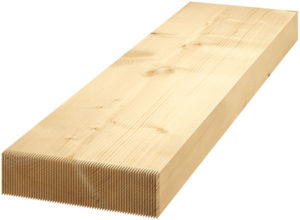The principle
Finger jointing is a special method of joining wood along its length that utilises the principle of wedging. It uses a standardised profile with many small wedges that is pressed with great force into a corresponding opposite profile. It’s already impossible to take this force-fit joint apart again by hand. It is then possible through the application of glue to create joints that may be subjected to permanent loads and whose structural properties can be calculated. The only difference between horizontal and vertical finger jointing is the cutting angle that is rotated by 90°.
Vertical finger jointing
Vertical or upright finger jointing is the conventional method used. Compared with the horizontal method, its benefit lies in its rapid production that results from the fact that the shorter board sides are machined. Which helps reduce sales prices. The profile on this economic and rational joint remains visible where the connection is made.

Vertical finger jointing
- Low-cost because production has been rationalised
Horizontal finger jointing à la Weinberger
Horizontal or lateral finger jointing, on the other hand, is a special method of production by which the longer section of the board is machined. Weinberger enhances this profile with an edge finger jointing that has no effect on plank strength. The result: a straight joint in the shape of a discreet line that only becomes noticeable on closer scrutiny. This is another reason why Weinberger is an appreciated partner in modern and demanding log-house construction.

Horizontal finger jointing with edge jointing
- Edge finger jointing makes the joins almost invisible
- Does not affect the strength
- Ideal for high-quality log-house building

















